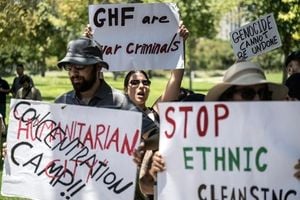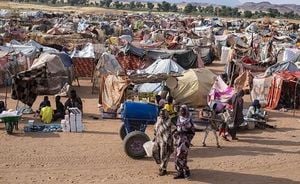Inside a nondescript building in Kiryat Gat, Israel—just thirteen miles north of the battered Gaza Strip—U.S. Army officers, Israeli Defense Forces personnel, and a host of international officials huddle around glowing screens. Maps and satellite imagery of Gaza flicker in the dim light, their lines and colors now the language of a new phase of war: the so-called “stabilisation” of a place that, for two years, has been synonymous with destruction and suffering. According to Getty Images, this Civil-Military Coordination Center (CMCC) has rapidly expanded in recent weeks, now involving dozens of countries and organizations. But as the world’s attention shifts from bombs to blueprints, many are questioning whether the international community’s new approach offers hope—or simply another layer of remote control.
The numbers are staggering. More than seventy thousand Palestinians have been killed in Gaza over the last two years, and most of the territory has been reduced to rubble. Despite the devastation, critics say the world’s most powerful governments produced little more than “empty warnings, sham ceasefires and aid arrangements that delivered death instead of relief,” as reported by Al Jazeera. Even after a recent ceasefire, the violence has hardly abated—over 340 Palestinians have been killed since the supposed truce began, and entire neighborhoods have been wiped out in recent weeks, according to Socialist Party sources.
The CMCC, presented as the first concrete step in the U.S. effort to “stabilise” Gaza, is a hub where foreign officials oversee the Strip from a distance and begin shaping the model that will govern its future. Yet, as Al Jazeera notes, there is a glaring absence of formal Palestinian representation in these discussions. Instead, the architects of stability are “positioning themselves alongside Israel’s military,” a move that many see as turning “the promise of peace into yet another instrument of control.”
This isn’t the first time Gaza has been the subject of international peacekeeping experiments. The United Nations Interim Force in Lebanon (UNIFIL) once inspired hope among Palestinians that peacekeepers might shield them from violence. But as one observer reflected to Al Jazeera, “I realised that a force unable even to protect itself from Israel’s attacks could never protect anyone else. They weren’t saviours; they were observers, watching atrocities unfold, powerless or unwilling to intervene.”
Critics argue that the new “International Stabilisation Force,” floated as part of a Trump-led peace plan, is little more than a rebranding of failed models. The plan would see an authority imposed on Gaza from outside, enforced by troops from various countries. But, as Socialist Party reporting highlights, “none have been readily committing to it as they fear those troops will be viewed as aiding the Israeli regime’s agenda.” Even a Guardian editorial admitted the proposal “looks like a colonial authority.”
Meanwhile, the Israeli government led by Benjamin Netanyahu is maintaining direct control over more than half of the Gaza Strip, according to Socialist Party sources. A U.S. official described the prospect of reunifying the territory as only “aspirational.” The ceasefire deal, critics say, is “fundamentally in the interests of the world’s imperialist powers and Israeli capitalism,” offering no promise of Israeli military withdrawal or a Palestinian state—just vague prospects “loaded with caveats.”
The United Nations Security Council agreed to the plan on November 17, 2025, without any of its fifteen member countries applying a veto. While some interpret this as a sign of less tolerance for Israeli actions, others believe it reflects not concern for Palestinians, but “concern over the anger being expressed from below globally, the added instability across the Middle East caused by the war and other Israeli state aggressions, and the damage the imperialist powers see Israeli capitalism as doing to its own interests,” according to the Socialist Party.
Popular anger is indeed boiling over. In October 2025, a general strike in Italy supported the Global Sumud flotilla’s attempt to deliver aid to Gaza. In the U.S., a marked shift in public opinion has taken place: one poll showed 43% of Americans believe Israel has committed genocide in Gaza, and another indicated a majority now oppose sending additional aid to Israel. Demonstrations and workers’ actions are continuing globally, with protestors demanding an end to Israeli military actions and supporting Palestinian democratic struggles.
Yet, on the ground in Gaza, the reality is grim. The U.S. Gaza Humanitarian Foundation (GHF), a U.S.-run program established to control and distribute aid during Israel’s intensified blockade, has become a symbol of how foreign involvement can feed violence. Al Jazeera reports that over 2,600 Palestinians were killed under Israeli fire while American officers observed. “The GHF killing traps,” as some have dubbed them, turned the distribution of food into a deadly game, with desperate civilians caught in the crossfire.
For many Palestinians, the promise of “stabilisation” rings hollow. Aid is weaponised, every basic necessity treated as a privilege to be earned—not a right. As Al Jazeera puts it, “There can be no real security when even food is still weaponised as international ‘peace planners’ debate how we should be fed rather than lifting the siege.” Survival is not guaranteed, and the so-called post-ceasefire era feels like “another experiment in the post-genocide laboratory, where Gaza is reshaped to fit outsider visions of ‘stability’.”
Meanwhile, Israel continues to operate with impunity. The state, internationally accused of genocide, “has committed every imaginable crime, waged multiple unprovoked wars, and still holds an entire population hostage, even as Gaza is framed as the side in need of ‘stabilisation’,” Al Jazeera reports. The world’s focus, critics argue, is misplaced: “Instead of portraying Palestinians as the threatening force, the world must restrain and hold to account those who wield real power to destroy lives daily.”
Some see hope in the growing tide of resistance and solidarity. The Socialist Party calls for continued demonstrations and workers’ actions, arguing that only through “democratically organised struggles by Palestinians for defence and towards liberation” can there be meaningful change. The party envisions an independent, socialist Palestinian state alongside a democratic socialist Israel, as part of a voluntary, equal socialist confederation in the region that can end war, oppression and poverty.
But for now, the people of Gaza remain trapped in a cycle of violence and deprivation, their fate debated in distant rooms by those who rarely set foot among them. As the world watches, the question remains: will these new international efforts bring real relief and justice—or simply reinforce the cage?
Ultimately, stability for Gaza and the wider region will depend not on remote-controlled peacekeeping or foreign-imposed solutions, but on confronting the root causes of violence and holding those responsible to account. Until then, the promise of peace remains just that—a promise, not yet delivered.





